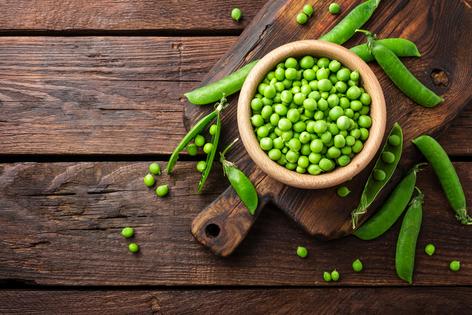Environmental Nutrition: Pass the peas!
Green peas by any other name — English, garden, shell, sweet — are just as delightful. Not to be confused with snow peas or snap peas, whose tender pods are edible, green peas are the tiny round gems shelled from the pod.
The folklore
One of the first cultivated foods, peas date back thousands of years to central Asia and the Middle East. Known as a favorite staple food, the pea enjoys storied fame, from nursery rhymes and fairy tales to global cuisines. This legume is literally pea-sized and packed with powerful nutrients that continue to please palates.
The facts
Green peas (Pisum sativum) are not vegetables, but legumes, like beans, chickpeas and lentils. The three types of peas — green peas, snow peas and snap peas — are among the few legumes that are eaten fresh, rather than dried. Most are sold frozen or canned because fresh peas don’t keep well once harvested. All forms of peas are packed with nutrients — a half-cup serving of cooked peas serves up a hefty amount of antioxidant vitamins A and C —13% DV and 19% DV per serving, respectively — as well as more than 10% each of the heart healthy B vitamins thiamin and folate.
The findings
Green peas are plump with phytonutrients, plant chemicals that show health-protecting properties. According to a 2017 review of studies, peas contain high levels of several antioxidant and anticancer compounds, including isoflavones and saponins, which are associated with the prevention of diseases such as cancer and cardiovascular disease (Pharmacognosy Review). Peas, which are high in plant protein and fiber, as part of a plant-based diet, have been associated with lower cholesterol, improved blood pressure, and improvement of other risk factors for cardiovascular disease (Progress in Cardiovascular Diseases, 2018).
The finer points
Fresh peas are a hard-to-find treat. If you spot them between spring and early winter, choose bright green, unflawed pods — smaller are sweeter. They’re best eaten right away, but will store refrigerated a few days. Otherwise, choose frozen over canned peas for lower sodium, brighter color, and firmer texture. Consume them within six months to a year to retain optimal nutrients. Peas bring color and sweetness to any dish — salads, whole grain sides, soups — and they definitely shine on their own or, classically, with carrots, or sauteed with mushrooms and nuts. Best yet, enjoy this healthy snack straight from the shell.
(Environmental Nutrition is the award-winning independent newsletter written by nutrition experts dedicated to providing readers up-to-date, accurate information about health and nutrition in clear, concise English. For more information, visit www.environmentalnutrition.com.)
©2021 Belvoir Media Group, LLC. Distributed by Tribune Content Agency, LLC.







